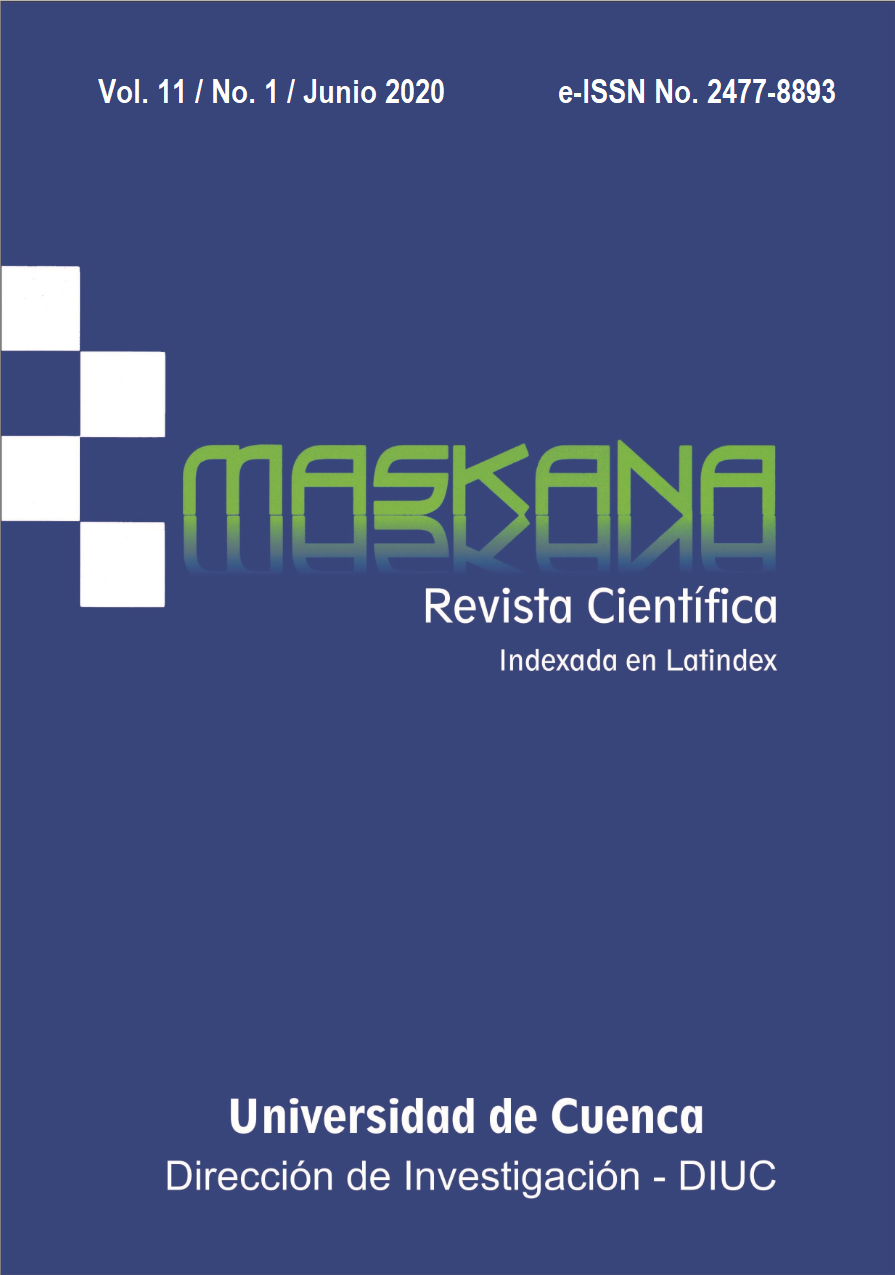Análisis espacial de PM10 en el aire y su composición de metales con relación a factores ambientales alrededor de centros de educación preescolar en Cuenca
DOI:
https://doi.org/10.18537/mskn.11.01.06Palabras clave:
Material particulado, metales pesados, efectos en la salud, factores ambientales, CuencaResumen
La contaminación del aire por Material Particulado (PM), como consecuencia del aumento del tráfico, es de gran preocupación para la salud pública en las zonas urbanas. El PM llama mucho la atención, primero porque, debido a su tamaño micrométrico, las partículas pueden penetrar en los pulmones e impedir el intercambio de gases, y en segundo lugar debido a su composición química, incluida la presencia de metales pesados, que pueden dañar los sistemas biológicos. A pesar de sus efectos perjudiciales para toda la población, los niños son más vulnerables debido a su organismo en desarrollo. Se sabe que las concentraciones de PM pueden verse influenciadas por las características de la calle, la meteorología y la presencia de vegetación circundante, que constituyen factores ambientales relacionados con la generación, dispersión y deposición de PM. Debido a la necesidad de reducir la exposición de la población a este tipo de contaminación, el presente estudio analizó la correlación de los factores ambientales de generación, dispersión y deposición en función de la información secundaria disponible con la concentración de PM10 y metales (plomo, cadmio, cobre, y zinc) en muestras de aire recolectadas en 21 centros de educación inicial en la ciudad de Cuenca. Los resultados obtenidos indican bajas relaciones entre contaminantes y factores ambientales, la presencia de alta variabilidad en las concentraciones de contaminantes y niveles de PM10 que a menudo exceden los límites establecidos por la Organización Mundial de la Salud y la legislación nacional.
Descargas
Métricas
Citas
Agency for Toxic Substances & Disesase Registry. (2017). Lead (Pb) Toxicity: What are the U.S. standards for lead levels? 185 pp. USA: Agency for Toxic Substances and Disease Registry https://www.atsdr.cdc.gov/csem/csem.asp?csem=34&po=8
Astudillo-Alemán, A. L., Ramirez Orellana, M. I., Garcia Alvear, N. B., Gónzales Arévalo, G. J., Gutierrez Valle, I. A., & Bailón Moscoso, N. C. (2015). Caracterización química del material particulado PM10 de la zona urbana de Cuenca- Ecuador e investigación de su genotoxicidad e inducción de estrés oxidativo en células epiteliales alveolares A549. Revista de Toxicología, 32, 121-126.
Bost, M., Houdart, S., Oberli, M., Kalonji, E., Huneau, J. F., & Margaritis, I. (2016). Dietary copper and human health: Current evidence and unresolved issues. Journal of Trace Elements in Medicine and Biology, 35, 107-115. https://doi.org/10.1016/j.jtemb.2016.02.006
Buyadi, S. N. A., Mohd, W. M. N. W., & Misni, A. (2015). Vegetation’s Role on Modifying Microclimate of Urban Resident. Procedia - Social and Behavioral Sciences, 202(December 2014), 400-407. https://doi.org/10.1016/j.sbspro.2015.08.244
Cakmak, S., Dales, R., Kauri, L. M., Mahmud, M., Van Ryswyk, K., Vanos, J., Liu, L., Kumarathasan, P., Thomson, E., Vincent, R., & Weichenthal, S. (2014). Metal composition of fine particulate air pollution and acute changes in cardiorespiratory physiology. Environmental Pollution, 189, 208-214. https://doi.org/10.1016/j.envpol.2014.03.004
Cordero, X., & Guillén, V. (2013). Diseño y validación de vivienda bioclimática para la ciudad de Cuenca. 2, 61-75. https://publicaciones.ucuenca.edu.ec/ojs/index.php/estoa/article/ viewFile/303/256
Donahue, N. M. (2018). Air Pollution and Air Quality. Green Chemistry, 151-176. https://doi.org/10.1016/B978-0-12-809270-5.00007-8
EMOV EP. (2014). Inventario de Emisiones Atmosféricas del Canton Cuenca 2014. Emov Ep, Red de monitoreo de la calidad del aire de Cuenca, December, 76. https://doi.org/10.13140/RG.2.2.17665.66405
Farghaly, O. A., & Ghandour, M. A. (2005). Square-wave stripping voltammetry for direct determination of eight heavy metals in soil and indoor-airborne particulate matter. Environmental Research, 97(3), 229-235. https://doi.org/10.1016/j.envres.2004.07.007
Flora, S. J. S., Flora, G., & Saxena, G. (2006). Environmental occurrence, health effects and management of lead poisoning. In: Lead (pp. 158-228). Elsevier. https://doi.org/10.1016/B978-044452945-9/50004-X
Fortoul, T. I., Rodriguez-Lara, V., Gonzalez-Villalva, A., Rojas-Lemus, M., Colin-Barenque, L., Bizarro-Nevares, P., García-Peláez, I., Ustarroz-Cano, M., López-Zepeda, S., Cervantes-Yépez, S., López-Valdez, N., Meléndez-García, N., Espinosa-Zurutuza, M., Cano-Gutierrez, G., & Cano-Rodríguez, M. C. (2015). Health Effects of Metals in Particulate Matter. In: Current Air Quality Issues: Vol. i (Issue tourism, p. 13). InTech. https://doi.org/10.5772/59749
GAD Municipal. (2014). Categorización de la demanda de transporte de Cuenca. 1.
Ilustre Municipalidad de Cuenca. (2015). Plan de Desarrollo y ordenamiento territorial del Cantón Cuenca.
Ishida, S., Andreux, P., Poitry-Yamate, C., Auwerx, J., & Hanahan, D. (2013). Bioavailable copper modulates oxidative phosphorylation and growth of tumors. Proceedings of the National Academy of Sciences, 110(48), 19507-19512. https://doi.org/10.1073/pnas.1318431110
Janhäll, S. (2015). Review on urban vegetation and particle air pollution - Deposition and dispersion. Atmospheric Environment, 105, 130-137. https://doi.org/10.1016/j.atmosenv.2015.01.052
Jenks, G. F. (1967). The data model concept in statistical mapping. International Yearbook of Cartography, 8(4), e61104.
Jiang, L.-F., Yao, T.-M., Zhu, Z.-L., Wang, C., & Ji, L.-N. (2007). Impacts of Cd(II) on the conformation and self-aggregation of Alzheimer’s tau fragment corresponding to the third repeat of microtubule-binding domain. Biochimica et Biophysica Acta (BBA) - Proteins and Proteomics, 1774(11), 1414-1421. https://doi.org/10.1016/j.bbapap.2007.08.014
Kalisa, E., Fadlallah, S., Amani, M., Nahayo, L., & Habiyaremye, G. (2018). Temperature and air pollution relationship during heatwaves in Birmingham, UK. Sustainable Cities and Society, 43, 111-120. https://doi.org/10.1016/j.scs.2018.08.033
Karner, A. A., Eisinger, D. S., & Niemeier, D. A. (2010). Near-roadway air quality: Synthesizing the findings from real-world data. Environmental Science and Technology, 44(14), 5334-5344. https://doi.org/10.1021/es100008x
Kim, C.-H., Yoo, D.-C., Kwon, Y.-M., Han, W.-S., Kim, G.-S., Park, M.-J., Kim, Y.-S., & Choi, D.-W. (2010). A study on characteristics of atmospheric heavy metals in subway station. Toxicological Research, 26(2), 157-162. https://doi.org/10.5487/TR.2010.26.2.157
Kliengchuay, W., Meeyai, A. C., Worakhunpiset, S., & Tantrakarnapa, K. (2018). Relationships between meteorological parameters and particulate matter in Mae Hong Son province, Thailand. International Journal of Environmental Research and Public Health, 15(12), 1-13. https://doi.org/10.3390/ijerph15122801
Laing, S., Wang, G., Briazova, T., Zhang, C., Wang, A., Zheng, Z., Gow, A., Chen, A. F., Rajagopalan, S., Chen, L. C., Sun, Q., & Zhang, K. (2010). Airborne particulate matter selectively activates endoplasmic reticulum stress response in the lung and liver tissues. American Journal of Physiology-Cell Physiology, 299(4), C736-C749. https://doi.org/10.1152/ajpcell.00529.2009
Landsat 8 Data Users Handbook (2018). Landsat missions. https://landsat.usgs.gov/landsat-8-l8-data-users-handbook-section-5
Lenschow, P. (2001). Some ideas about the sources of PM10. Atmospheric Environment, 35(1), 23-33. https://doi.org/10.1016/S1352-2310(01)00122-4
Li, H., Qian, X., & Wang, Q. (2013). Heavy metals in atmospheric particulate matter: A comprehensive understanding is needed for monitoring and risk mitigation. Environmental Science and Technology, 47(23), 13210-13211. https://doi.org/10.1021/es404751a
Martini, A., Biondi, D., Batista, A. C., Martini, A., Biondi, D., & Batista, A. C. (2018). Distance and intensity of microclimatic influence provided by urban forest typologies. Floresta e Ambiente, 25(2), 1-12. https://doi.org/10.1590/2179-8087.021317
Mejia, D., Zegarra, R., Astudillo, A., & Moscoso, D. (2018). Análisis de partículas sedimentables y niveles de presión sonora en el área urbana y periférica de Cuenca. Revista de La Facultad de Ciencias Químicas, 19, 55-64.
Mohankumar, S., & Senthilkumar, P. (2017). Particulate matter formation and its control methodologies for diesel engine: A comprehensive review. Renewable and Sustainable Energy Reviews, 80(June), 1227-1238. https://doi.org/10.1016/j.rser.2017.05.133
Mohanraj, R., Azeez, P. A., & Priscilla, T. (2004). Heavy metals in airborne particulate matter of urban Coimbatore. Archives of Environmental Contamination and Toxicology, 47(2), 162-167. https://doi.org/10.1007/s00244-004-3054-9
Monks, P., Allan, J., Carruthers, D., Carslaw, D., Fuller, G., OBE, R. H., Heal, M., Lewis, A., Nemitz, E., Williams, M., & Reeves, C. (2013). Non-exhaust emissions from road traffic. 93 pp. Disponible en https://uk-air.defra.gov.uk/assets/documents/reports/cat09/1907101151_20190709_Non_Exhaust_Emissions_typeset_Final.pdf
Niu, J., Liberda, E. N., Qu, S., Guo, X., Li, X., Zhang, J., Meng, J., Yan, B., Li, N., Zhong, M., Ito, K., Wildman, R., Liu, H., Chen, L. C., & Qu, Q. (2013). The role of metal components in the cardiovascular effects of PM2.5. PLoS ONE, 8(12), e83782. https://doi.org/10.1371/journal.pone.0083782
Penkała, M., Ogrodnik, P., & Rogula-Kozłowska, W. (2018). Particulate matter from the road surface abrasion as a problem of non-exhaust emission control. Environments, 5(1), 1-13. https://doi.org/10.3390/environments5010009
Perera, F. (2018). Pollution from fossil-fuel combustion is the leading environmental threat to global pediatric health and equity: Solutions exist. International Journal of Environmental Research and Public Health, 15(1), 1-16. https://doi.org/10.3390/ijerph15010016
Popoola, L. T., Adebanjo, S. A., & Adeoye, B. K. (2018). Assessment of atmospheric particulate matter and heavy metals: a critical review. International Journal of Environmental Science and Technology, 15(5), 935-948. https://doi.org/10.1007/s13762-017-1454-4
Rehman, K., Fatima, F., Waheed, I., & Akash, M. S. H. (2018). Prevalence of exposure of heavy metals and their impact on health consequences. Journal of Cellular Biochemistry, 119(1), 157-184. https://doi.org/10.1002/jcb.26234
Rodas Espinoza, C. R., Mora Verdugo, M. A., Neira Molina, V. A., Andrade Tenesaca, D. S., Ochoa, A. M., Argudo, D. M., Parra, A., & Orellana, D. (2017). Enfermedades alérgicas. Ecuador: CEDIA. https://www.cedia.edu.ec/es/proyectos-ganadores/cepra-xi/enfermedades-alergicas
Roohani, N., Hurrell, R., Kelishadi, R., & Schulin, R. (2013). Zinc and its importance for human health: An integrative review. Journal of Research in Medical Sciences, 18(2), 144-157.
Roupsard, P., Amielh, M., Maro, D., Coppalle, A., Branger, H., Connan, O., Laguionie, P., Hébert, D., & Talbaut, M. (2013). Measurement in a wind tunnel of dry deposition velocities of submicron aerosol with associated turbulence onto rough and smooth urban surfaces. Journal of Aerosol Science, 55, 12-24. https://doi.org/10.1016/j.jaerosci.2012.07.006
Singh, K. B. (2012). Long term excessive Zn supplementation induced oxidative stress in Wistar rats fed on semi-synthetic diet. Food and Nutrition Sciences, 3(06), 724-731. https://doi.org/10.4236/fns.2012.36098
Tang, J., McNabola, A., Misstear, B., Pilla, F., & Alam, M. S. (2019). Assessing the impact of vehicle speed limits and fleet composition on air quality near a school. International Journal of Environmental Research and Public Health, 16(1), 1-23. https://doi.org/10.3390/ijerph16010149
Tarantino, G. (2013). Exposure to ambient air particulate matter and non-alcoholic fatty liver disease. World Journal of Gastroenterology, 19(25), 3951-3956. https://doi.org/10.3748/wjg.v19.i25.3951
U.S. Environmental Protection Agency. (2001). Control of emissions of hazardous air pollutants from mobile sources. USA: Environmental Protection Agency. 45 pp.
Wong, D. W., Yuan, L., & Perlin, S. A. (2004). Comparison of spatial interpolation methods for the estimation of air quality data. Journal of Exposure Analysis and Environmental Epidemiology, 14(5), 404-415. https://doi.org/10.1038/sj.jea.7500338
World Health Organization. (2006). Principles for evaluating health risks in children associated with exposure to chemicals (Vol. 237). 329 pp. Disponible en https://apps.who.int/iris/handle/10665/43604
World Health Organization (WHO). (2013). Review of evidence on health aspects of air pollution - REVIHAAP Project: final technical report. 309 pp. Disponible en http://www.euro.who.int/__data/assets/pdf_file/0004/193108/REVIHAAP-Final-technical-report-final-version.pdf?ua=1
Yitshak-Sade, M., Kloog, I., & Novack, V. (2017). Do air pollution and neighborhood greenness exposures improve the predicted cardiovascular risk? Environment International, 107, 147-153. https://doi.org/10.1016/j.envint.2017.07.011
Publicado
Cómo citar
Número
Sección
Licencia
Copyright © Autors. Creative Commons Attribution 4.0 License para cualquier artículo enviado a partir del 6 de junio de 2017. Para los manuscritos presentados anteriormente, se utilizó la licencia CC BY 3.0.
![]()
Usted es libre de:
 |
Compartir — compartir y redistribuir el material publicado en cualquier medio o formato. |
 |
Adaptar — combinar, transformar y construir sobre el material para cualquier propósito, incluso comercialmente. |
Bajo las siguientes condiciones:
 |
Atribución — Debe otorgar el crédito correspondiente, proporcionar un enlace a la licencia e indicar si se realizaron cambios. Puede hacerlo de cualquier manera razonable, pero de ninguna manera que sugiera que el licenciador lo respalda a usted o a su uso. |
| Sin restricciones adicionales: no puede aplicar términos legales o medidas tecnológicas que restrinjan legalmente a otros a hacer cualquier cosa que permita la licencia. |
Mayor información sobre este acuerdo de autoría y licencia, transferencia de derechos o solicitudes de reproducción, pueden ser consultados en este enlace.









